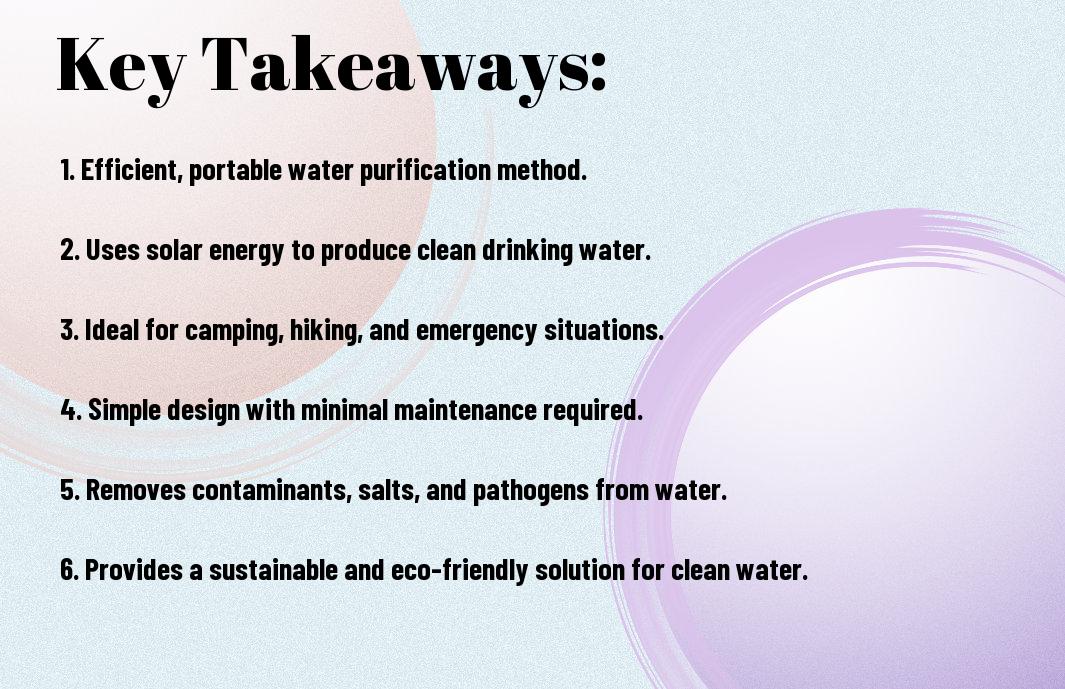It’s time to take your camping adventures to the next level with solar stills – a genius way to purify water in the great outdoors. When you’re out in the wild, knowing how to create a solar still can be a lifesaver. Here’s how you can ensure a safe and hydrated journey by harnessing the power of the sun to make your water safe to drink. Let’s investigate the world of solar stills and upgrade your camping experience!

What is a Solar Still?
Definition and Principle
An innovative way to purify water in the wild, a solar still is a device that uses the heat of the sun to distill water, making it safe for consumption. It operates on the principle of evaporation and condensation, replicating nature’s water cycle within a confined space.
History of Solar Stills
The concept of solar stills dates back centuries, with ancient civilizations using similar techniques to gather freshwater from saltwater sources. The design has evolved over time, with modern solar stills becoming more efficient and portable for outdoor enthusiasts.
The idea of using solar energy to purify water is not new and has been refined by scientists and survival experts alike. By harnessing the power of the sun, solar stills offer a sustainable and reliable method for obtaining clean drinking water in remote locations.
How Does a Solar Still Work?
Evaporation and Condensation Process
Some survival situations may call for you to purify water while out camping, and a solar still can be a valuable tool in such scenarios. To understand how a solar still works, let’s research into the process of evaporation and condensation.
When you set up a solar still by placing contaminated water in a pit or container covered with a plastic sheet, the sun’s heat causes the water to evaporate. As the water vapor rises, it collects on the underside of the plastic sheet, where it condenses back into liquid form. The condensed water then drips down into a collection container, leaving behind impurities and contaminants in the original water source.
Components of a Solar Still
To work effectively, a solar still requires a few key components. First, you need a container or pit to hold the contaminated water. Second, a transparent plastic sheet is used to cover the container, allowing sunlight to penetrate and heat the water inside. Lastly, a collection container placed below the plastic sheet is imperative for catching and storing the purified water that condenses. These components work together in a simple yet efficient way to provide you with a source of clean drinking water in the wilderness.
Benefits of Using a Solar Still
Despite the simplicity of their design, solar stills offer a multitude of benefits that make them an crucial tool for any camping adventure. Not only do they provide a reliable source of clean drinking water, but they also offer several advantages that set them apart from other water purification methods.
Water Purification in Remote Areas
On your outdoor excursions to remote areas where clean water sources are scarce, a solar still can be a lifesaver. By harnessing the power of the sun to evaporate and condense water, you can rely on this ingenious device to purify even the most questionable water sources, ensuring you stay hydrated and healthy throughout your journey.
Energy Efficiency and Eco-Friendliness
Efficiency is a key advantage of using a solar still for water purification. Unlike other methods that require fuel, electricity, or chemicals, a solar still operates solely on the energy of the sun. This eco-friendly approach not only reduces your carbon footprint but also eliminates the need to carry additional supplies, making it a lightweight and sustainable option for your camping gear.
Areas with abundant sunshine are ideal for maximizing the effectiveness of a solar still, as the more sunlight it receives, the faster and more efficiently it can purify water. This means that even in remote locations with limited resources, you can still depend on your solar still to provide you with a safe and steady supply of drinking water.
Cost-Effective Solution
An crucial benefit of using a solar still is its cost-effectiveness. Once you invest in a quality solar still, there are minimal ongoing expenses involved in maintaining or operating it. Unlike other water purification methods that require frequent filter replacements or chemical treatments, a solar still offers a long-term solution that saves you money in the long run.
Purification with a solar still is a one-time investment that pays off with each use, making it a practical and economical choice for ensuring access to clean water on all your camping adventures.
Types of Solar Stills
To ensure you have the best water purification method on your camping adventure, it’s vital to understand the different types of solar stills available. Here are the main types you should know about:
| Basin-Type Solar Stills | Trough-Type Solar Stills |
| Inclined Solar Stills |
Basin-Type Solar Stills
The basin-type solar stills are the most common and simple design. They consist of a basin that holds contaminated water and a transparent cover that captures the evaporated water and allows it to condense and collect as purified water. These stills are easy to set up and can be effective in producing drinkable water.
Though basin-type solar stills are relatively easy to construct, they may not be the most efficient method for large-scale water purification due to their limited capacity.
Trough-Type Solar Stills
Stills
Trough-type solar stills operate similarly to basin-type stills but have a more elongated design, allowing for a larger surface area for evaporation. This design enables them to produce more purified water compared to basin-type stills, making them a suitable option for situations where more water is needed.
BasinType
Inclined Solar Stills
Solar
Solar
Building Your Own Solar Still
For a successful camping trip where access to clean water may be limited, building your own solar still can be a lifesaver. With just a few simple materials and following these step-by-step instructions, you can create a device that effectively purifies water using the power of the sun.
Materials Needed
With the following materials on hand, you can easily construct your own solar still:
| Materials | Quantity |
| Plastic sheet or tarp | 1 |
| Container for collecting water | 1 |
| Rock or weight | 1 |
| Drinking tube (optional) | 1 |
Step-by-Step Construction Guide
Any successful construction of a solar still involves following these steps:
| Step | Instructions |
| 1 | Find a sunny spot and dig a hole in the ground. |
| 2 | Place your container in the center of the hole and fill it with water. |
| 3 | Place the plastic sheet over the hole, securing the edges with rocks or soil. |
| 4 | Place a rock or weight in the center of the plastic sheet to create a downward slope towards your container. |
| 5 | Place a drinking tube in the container to easily access the purified water (optional). |
To ensure the effectiveness of your solar still, make sure there are no tears or holes in the plastic sheet, as this can impact the condensation process.
Tips and Precautions
To enhance your solar still construction and ensure safe water consumption, consider the following tips and precautions:
- Choose a location with ample sunlight for optimal condensation.
- Regularly check and maintain your solar still to ensure proper functionality.
- Avoid using contaminated water sources, as the solar still may not effectively purify all types of pollutants.
This will help you make the most of your solar still and ensure you have access to clean drinking water during your camping adventure.
Using a Solar Still on Your Camping Adventure
Choosing the Right Location
Right from the start, it’s necessary to choose the right location for setting up your solar still. Look for an area with direct sunlight for most of the day. Placing your still on a flat surface will help it function more efficiently. Also, consider positioning it away from any obstructions that could block the sunlight, such as trees or rocks.
Maintenance and Troubleshooting
Location is key when it comes to maintaining your solar still. Regularly check on your still to ensure it’s in the optimal position to receive sunlight. If you notice a decrease in water collection or the still is not functioning as expected, check for any blockages or leaks in the system. Clear any obstructions and make sure all components are properly sealed to prevent any water loss.
Solar stills are relatively low maintenance, but it’s important to inspect them regularly to ensure they are working effectively. By staying on top of maintenance and promptly addressing any issues that arise, you can rely on your solar still to provide you with clean drinking water throughout your camping adventure.
Integrating with Other Water Purification Methods
The key to surviving in the wild is to be resourceful and versatile. The beauty of solar stills is that they can be easily integrated with other water purification methods to ensure you have a reliable source of clean water. Consider using water purification tablets or filters in conjunction with your solar still to further guarantee the safety of the water you collect.
Plus, by combining different purification methods, you can adapt to various environmental conditions and situations, making your camping adventure a true test of your survival skills. Do not forget, when it comes to purifying water in the great outdoors, redundancy is your friend.
Conclusion
With these considerations in mind, you now have a valuable tool in your arsenal for ensuring clean drinking water on your camping adventures. Solar stills offer a simple yet effective way to purify water using the power of the sun, giving you peace of mind knowing that you can stay hydrated even in remote locations.
So next time you’re planning a camping trip, remember to pack a solar still along with your other necessarys. Embrace the spirit of adventure and self-reliance, and always be prepared to take on the great outdoors with confidence.
